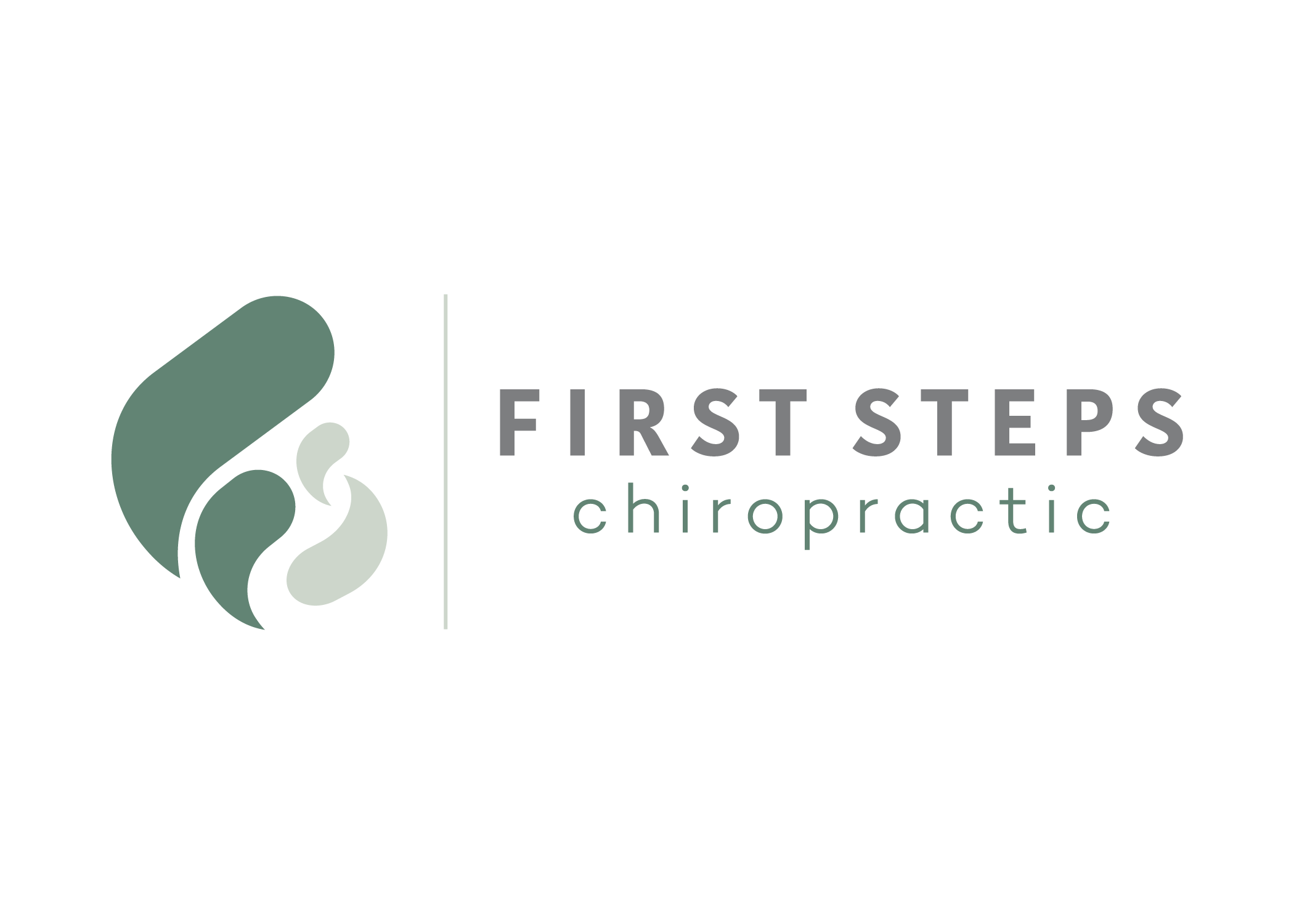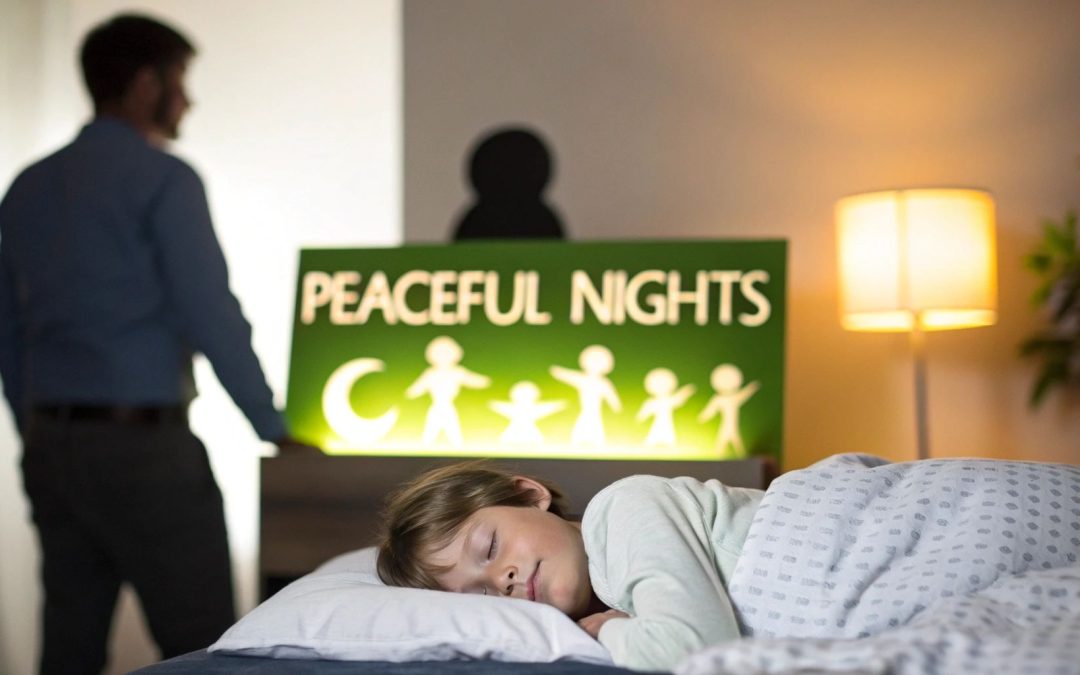If you’re the parent of an autistic child who has night terrors, know this: you aren’t alone. These intense episodes are deeply connected to the unique way an autistic brain works, which is why they happen more often in children on the spectrum.
It’s crucial to understand that these events are not the same as nightmares. Even though it's incredibly upsetting to watch, your child is fast asleep and won't remember a thing.
The Link Between Night Terrors and Autism
Watching your child suddenly scream, thrash around, or sit bolt upright with their eyes wide open is a terrifying experience for any parent. When your child is autistic, these moments can feel even more bewildering. The first step toward helping your child—and yourself—is to get a clear picture of what’s really going on.
The connection between night terrors and autism isn't just a coincidence; it's a well-documented pattern. Studies consistently show that children with Autism Spectrum Disorder (ASD) have a much higher rate of parasomnias (disruptive sleep events) like night terrors.
In fact, one significant study revealed that over half of autistic children with sleep issues showed clear signs of parasomnias, with many having multiple episodes in a single night. You can learn more about these specific sleep disorder findings to see just how common this is.
To help you tell these two apart, here is a quick comparison of night terrors and nightmares.
Night Terrors vs Nightmares in Autistic Children
It's easy to confuse these two sleep disturbances, but knowing the difference is key to responding in the most helpful way. This table breaks down the main characteristics of each.
| Characteristic | Night Terrors | Nightmares |
|---|---|---|
| When It Happens | Usually in the first third of the night (deep non-REM sleep). | Typically in the last third of the night (during REM sleep). |
| Child's State | Deeply asleep, though eyes may be open; inconsolable. | Wakes up fully and is aware of their surroundings. |
| Physical Signs | Thrashing, kicking, screaming, sweating, rapid heart rate. | May cry or call out, but less intense physical movement. |
| Memory of Event | No memory of the episode the next morning. | Can often recall details of the bad dream. |
| Consolability | Cannot be comforted or reasoned with during the episode. | Can be soothed and comforted by a parent. |
| Returning to Sleep | Falls back into a deep sleep quickly once the episode ends. | May have trouble falling back to sleep due to fear. |
Understanding these distinctions helps you react appropriately—by ensuring safety during a night terror versus offering comfort after a nightmare.
Why Are Night Terrors More Common in Autistic Children?
So, what makes autistic children more prone to these episodes?
Think of the brain shifting into deep sleep like a pilot landing a plane. For most people, it's a smooth descent. But for an autistic child, whose nervous system is already working overtime to manage sensory input and anxiety, that landing can be pretty bumpy.
This "turbulence" makes them much more likely to have a partial arousal—where the body is stuck somewhere between being asleep and being awake. This is the exact moment a night terror is triggered.
Several core traits of autism play a direct role in this:
- Sensory Sensitivities: An autistic child’s brain is often highly attuned to the environment. Even during sleep, a slight change in room temperature, the hum of a fan, or the texture of their pajamas can be enough to disrupt their sleep cycle.
- Anxiety and Stress: Higher levels of daytime anxiety and stress make it tough for the nervous system to truly switch off at night. It stays in a state of high alert, ready to react to the smallest disturbance.
- Irregular Sleep-Wake Cycles: Many autistic children struggle with their internal body clock (circadian rhythm). This can throw off the natural progression of sleep stages, creating more opportunities for these partial arousals to happen.
This infographic helps visualize how common autistic traits can increase the risk of night terrors and which support strategies can make a real difference.
As you can see, it’s not just about managing the episodes as they happen. It’s about creating a foundation for peaceful sleep by addressing the root causes through targeted support, like building consistent routines and making simple environmental adjustments.
Why Sleep Can Be a Struggle for Autistic Children
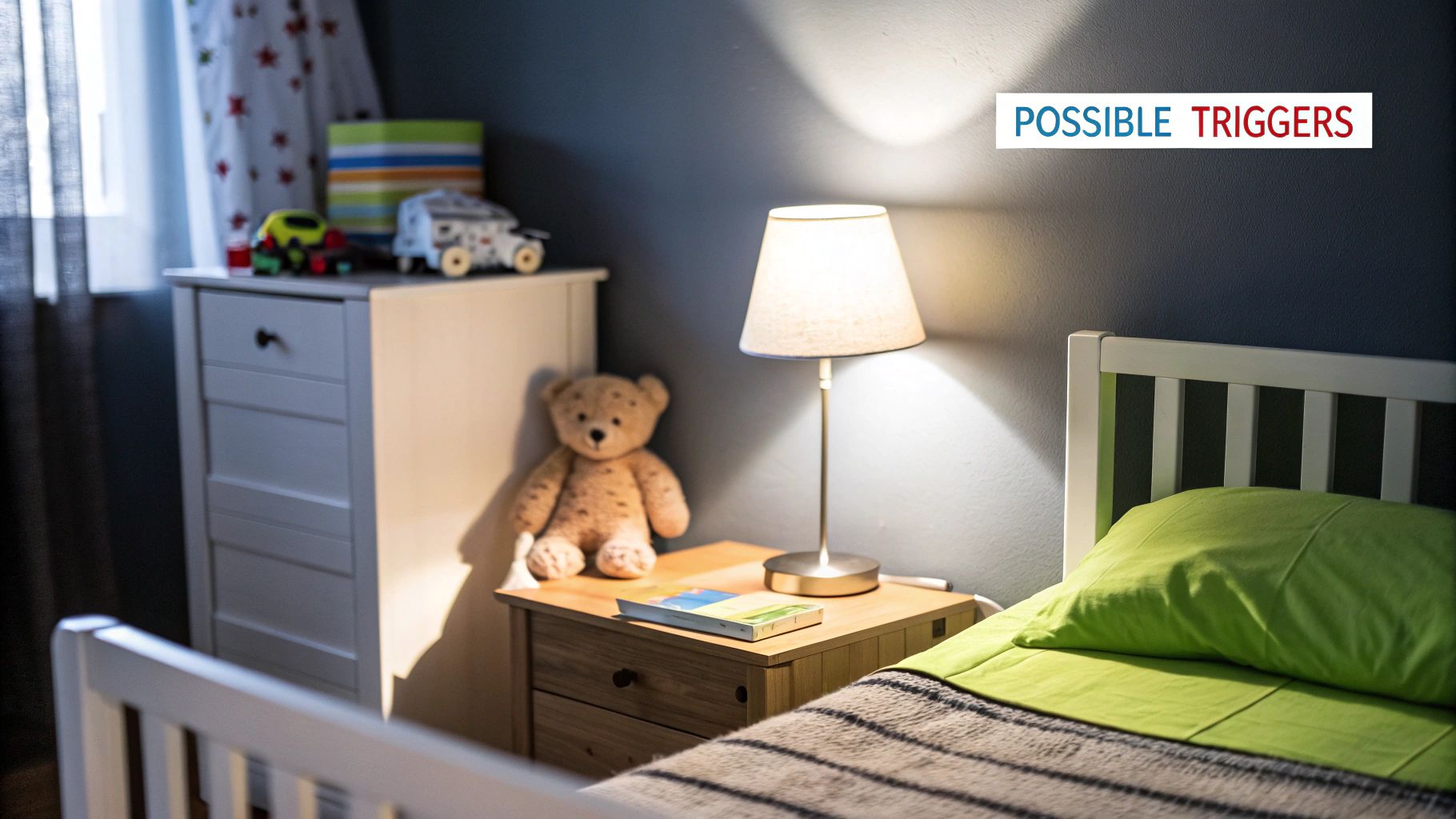
For parents of autistic children, getting a peaceful night's sleep can sometimes feel like an impossible goal. It’s far more than just typical childhood restlessness; the challenges are deeply connected to the unique way their nervous systems experience the world. This heightened sensitivity can turn the simple act of falling and staying asleep into a nightly battle.
This is often where the link between night terrors and autism begins. The underlying sleep difficulties create the perfect storm for these frightening episodes to occur. The statistics really drive this home—research shows that between 50% and 80% of autistic children deal with significant sleep disturbances, which is a far higher rate than their neurotypical peers. These issues can range from taking hours to fall asleep to waking up frequently throughout the night. For a deep dive into the data, you can explore the full research on autism and sleep difficulties on frontiersin.org.
Let’s break down a few of the key reasons why bedtime can become such a source of stress for the whole family.
Sensory Overload at Night
One of the biggest hurdles is Sensory Processing Disorder (SPD), a condition that very often goes hand-in-hand with autism. When a child has SPD, their brain has trouble interpreting everyday sensory input. What might seem like a minor background noise to you can feel like a blaring siren to them.
Think about trying to sleep with a loud, dripping faucet right next to your head. For an autistic child, that "drip" could be something as subtle as:
- The quiet hum of an appliance downstairs.
- The itchy feeling of a tag on their pajamas.
- A tiny sliver of light peeking under the bedroom door.
These seemingly small things can keep their nervous system on high alert, making it impossible to sink into the deep, restorative sleep that prevents partial arousals like night terrors. Their brain just can't filter out the "noise" and fully power down.
The Role of Anxiety and a Busy Mind
Anxiety is another major sleep thief. Many autistic children carry high levels of anxiety from navigating a world full of confusing social cues and overwhelming sensory demands. That stress doesn't just magically vanish when their head hits the pillow.
Instead, their minds can get stuck on replay, looping worries or fixating on every detail of the day's events. This makes it incredibly difficult to "switch off." This constant mental chatter keeps their nervous system stuck in a "fight-or-flight" mode, which is the complete opposite of the calm "rest and digest" state needed for sleep. This chronic state of alert is a classic sign of a dysregulated nervous system, a topic you can learn more about in our detailed guide.
When the nervous system is perpetually on guard, it struggles to transition smoothly between sleep stages. This rocky transition is precisely where night terrors tend to occur, emerging from that chaotic space between deep sleep and wakefulness.
Irregular Melatonin and Sleep Cycles
Finally, we have to look at physiology. Melatonin, the hormone that governs our sleep-wake cycles, can be produced differently in some autistic children. It’s as if their body’s internal clock—their natural circadian rhythm—is running on its own unpredictable schedule.
This disruption means their body might not get the memo that it's time for sleep, leading to problems falling asleep and staying asleep. When the entire sleep cycle is unstable, it creates more opportunities for the brain to get "stuck" in those messy transitional phases where night terrors autism events are most likely to erupt.
Recognizing Night Terrors in Nonverbal Children
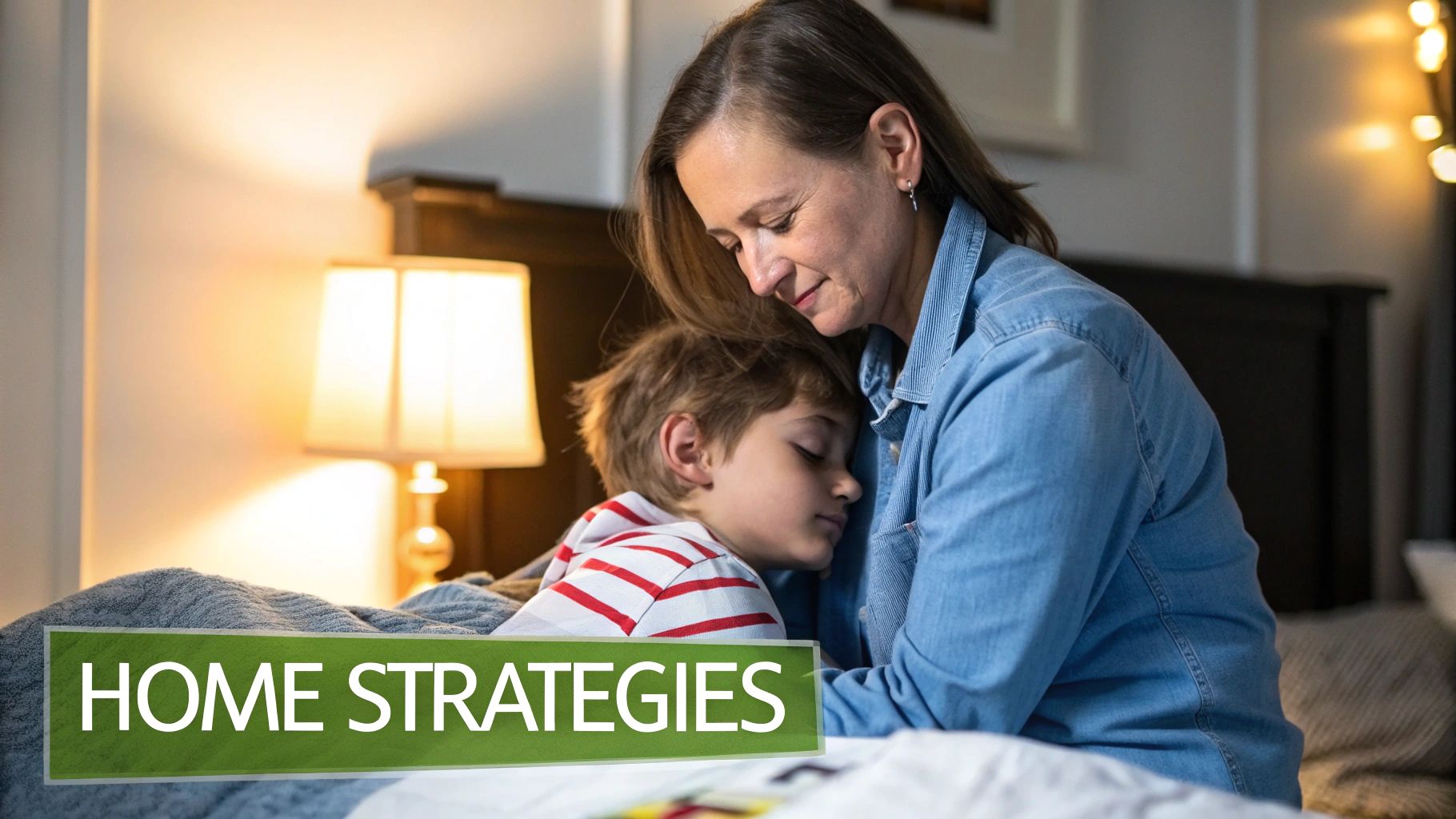
When a child is nonverbal or has limited speech, it can be incredibly challenging to understand what they're experiencing. This is especially true during the night. The link between night terrors and autism is well-established, but how do you identify one when your child can’t tell you what's wrong?
You have to become a bit of a detective, learning to read the physical clues they’re giving you. These episodes aren't just bad dreams; they are much more intense and physical, and the signs are quite distinct once you know what to watch for.
Beyond the Obvious Signs
We often associate night terrors with a blood-curdling scream, but many nonverbal children express their terror in completely different ways. Instead of a single sign, you’re usually looking for a cluster of behaviors that happen all at once.
Even without a scream, the physical reactions can be dramatic. Look for things like:
- Sudden, Intense Thrashing: This goes way beyond typical restless sleep. We're talking about abrupt, almost violent movements—kicking their legs, flailing their arms, or trying to scramble out of bed in a panicked, clumsy way.
- A Wide-Eyed, Glassy Stare: This one is particularly unsettling. Their eyes might be wide open, but they aren't actually seeing you. It’s a vacant, terrified look that tells you they are still fast asleep, even though they appear to be awake.
- Profuse Sweating and Rapid Heartbeat: You might notice their pajamas feel damp, or if you gently touch their chest, you can feel their heart racing. These are classic physical signs that their body's "fight-or-flight" system has kicked into high gear.
Perhaps the most telling sign is that they are completely unreachable. No matter what you say or do, you just can't get through to them.
A core feature of a night terror is that the child is inconsolable and unaware of your presence. Trying to hold or comfort them usually has no effect because, in their mind, you aren't really there. This is a huge clue that separates a night terror from a nightmare, where a child almost always wants and responds to comfort.
Documenting Episodes for Clarity
Keeping a simple log of these episodes can be a game-changer. You don't need to be a sleep expert—the goal is just to collect clear, simple facts that you can share with professionals, whether it's your pediatrician or a pediatric chiropractor.
After things have settled down, just jot down a few key points:
- Timing: About what time did it happen? (e.g., roughly 90 minutes after they fell asleep).
- Duration: How long did the episode last? (e.g., about 5-10 minutes).
- Specific Behaviors: What exactly did you see? (e.g., sat bolt upright, stared at the ceiling, kicked legs, was sweating).
This kind of record helps you and your child's care team spot patterns. It turns vague concerns into concrete data, making it so much easier to find the right solutions and support.
When you see your child in the middle of a night terror, every instinct screams to rush in, hug them, and wake them up. But for both neurotypical and autistic children, that's often the last thing you should do. Moving from understanding why this is happening to knowing what to do in the moment is what will give you confidence when it matters most.
The single most important rule is to prioritize safety over intervention. Your child is stuck in a very deep stage of sleep, so trying to force them awake can seriously backfire. It often makes them more confused and can even make the episode last longer. They aren't having a bad dream and have no idea you're even there, so your comforting words and touch won't register and might just make them more agitated.
In this storm, your calm presence is the anchor.
Your Step-by-Step Action Plan
Think of your role as being a quiet guardian. The goal isn't to stop the terror—it's to let it run its course without anyone getting hurt. Just focus on these simple, clear steps.
- Stay Calm and Observe: First, take a deep breath. Your own calm is absolutely essential. Remind yourself that your child isn't actually in distress and won't remember any of this. Just be there and watch over them.
- Ensure Physical Safety: Gently guide them away from anything that could hurt them. Clear the bedside table of sharp corners or objects, make sure they can’t fall out of bed, and block the top of the stairs if they start sleepwalking. The key is not to restrain them, but to use your body as a soft, protective barrier.
- Use a Quiet Voice (If Needed): If you feel you must speak, keep your voice low and soothing. Simple, quiet phrases like, "You're safe," or, "I'm here," might help without jolting them awake. Absolutely avoid turning on bright lights or making loud noises.
After the Episode Ends
Once the screaming and flailing stop, your child will likely drop right back into a deep sleep as if nothing happened. There’s really no need to bring it up the next morning. Since they won’t have any memory of it, talking about it could create a new source of anxiety around bedtime.
Your calm, measured response helps keep the environment stable, which is a huge deal for a child with the sensory sensitivities that often come with autism. This approach helps their nervous system transition back to peaceful sleep. If you want to learn more about calming an overstimulated system, our guide on parasympathetic nervous system stimulation is a great resource.
The goal is not to stop the night terror but to create a safe container for it to pass. By remaining a calm protector, you prevent injury and avoid making the partial arousal state more confusing for your child.
Understanding the bigger picture of night terrors and autism can also be reassuring. As the prevalence of Autism Spectrum Disorder (ASD) has risen, so has the focus on related challenges like sleep disturbances. To put it in perspective, historical data from the US ADDM Network showed that from 2000 to 2022, ASD prevalence in 8-year-olds went from 1 in 150 to 1 in 31—a fourfold increase. You can discover more insights about these trends on CDC.gov.
This dramatic increase really underscores why parents need effective, specialized strategies now more than ever.
How Pediatric Chiropractic Care Can Support Sleep
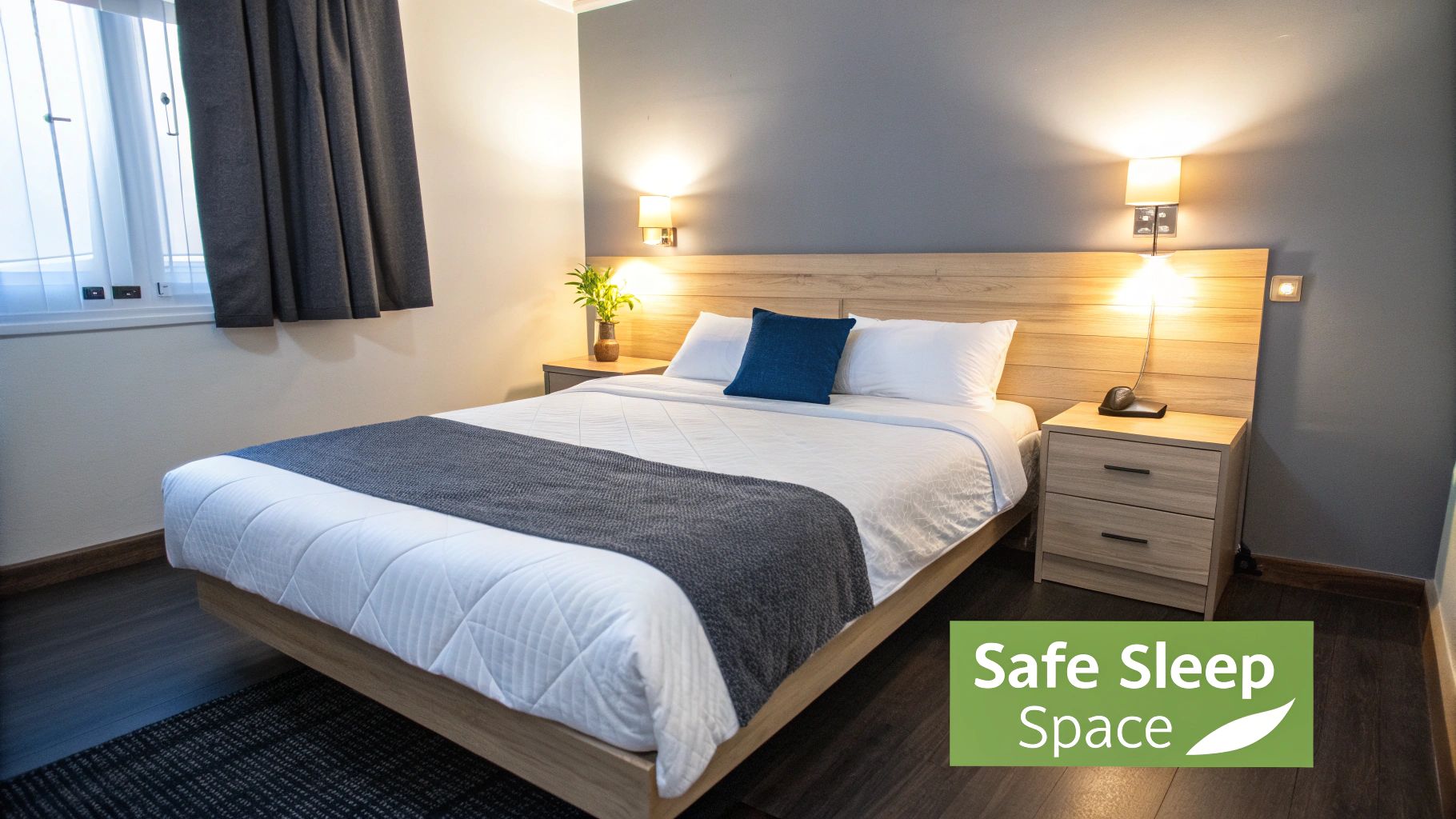
While creating a safe, calm space during a night terror is the immediate priority, most parents are understandably looking for ways to get ahead of the problem. You want to address what might be causing these sleep disruptions in the first place.
This is where neurologically-focused pediatric chiropractic care comes in. It’s a gentle, supportive approach that aims to calm the nervous system—which we often find is at the very heart of the link between night terrors and autism.
The care is built on a simple but powerful idea: a child's nervous system can get stuck in a "fight or flight" pattern. It's like a car's gas pedal is pushed down, even when it’s supposed to be parked and resting for the night. This constant state of high alert is often connected to physical tension and subtle misalignments in the spine, especially in the upper neck where the brainstem—the body's master control center—is located.
These tiny misalignments, which we call subluxations, can disrupt the smooth communication flowing between the brain and the body. The goal isn't to "treat" autism or night terrors directly. Instead, a pediatric chiropractor works to gently release that built-up tension, allowing the nervous system to finally find its "brake pedal."
The Stuck Gas Pedal Analogy
Let’s break that down a bit more. Think of your child’s nervous system as having two main modes of operation. You’ve got the “gas pedal,” known as the sympathetic system, which handles alertness, stress responses, and activity. Then there’s the “brake pedal,” or the parasympathetic system, which takes care of rest, digestion, healing, and calming down.
For many autistic children, the challenges of sensory overload and daily anxiety mean their "gas pedal" is floored all day long. When physical tension from spinal misalignments is added to the mix, it can keep that pedal stuck down, preventing the "brake pedal" from ever fully engaging at night. This state of constant alert makes it incredibly difficult for the body to transition smoothly into the deep, restorative stages of sleep.
Gentle chiropractic adjustments are designed to ease that physical stress. By carefully restoring proper alignment and motion, particularly in the upper cervical spine, we help the nervous system learn how to switch gears. It’s about encouraging the body to shift out of high-alert mode and into the "rest and digest" state needed for peaceful, uninterrupted sleep.
The core principle is simple: a calmer, more regulated nervous system during the day leads to a more balanced and peaceful nervous system at night. This shift can help smooth out the bumpy transitions between sleep stages where night terrors often occur.
While chiropractic care focuses on the nervous system, creating a supportive home environment is just as critical. Here are some proactive strategies parents can use to foster better sleep hygiene.
Proactive Strategies for Better Sleep in Autistic Children
This table outlines a few practical tips you can start implementing right away to create a more sleep-conducive routine and environment for your child.
| Strategy Area | Specific Action | Why It Helps |
|---|---|---|
| Sensory Environment | Use blackout curtains, a white noise machine, and weighted blankets. Ensure pajamas and bedding are of a preferred texture. | Minimizes sensory triggers that can disrupt sleep and provides comforting, deep-pressure input that calms the body. |
| Consistent Routine | Establish a predictable bedtime routine (e.g., bath, story, quiet time) that happens at the same time every night. | Signals to the brain and body that it's time to wind down, making the transition to sleep smoother and less abrupt. |
| Dietary Habits | Avoid sugary snacks and caffeine in the hours before bed. Consider a small, protein-rich snack if hunger is an issue. | Prevents blood sugar spikes and crashes that can interfere with sleep cycles and cause restlessness. |
| Physical Activity | Encourage active play during the day but transition to calming activities like stretching or reading in the evening. | Helps expend excess energy and regulates the body's internal clock, promoting natural sleepiness at night. |
Combining these home-based strategies with professional support can create a powerful, multi-faceted approach to improving your child's sleep quality.
How Gentle Adjustments Support Sleep Regulation
A trained pediatric chiropractor uses specific, gentle techniques that look very different from what you might imagine. There’s no popping, cracking, or twisting involved. These adjustments are designed to improve nervous system function in a few key ways:
- Reducing Nerve Interference: By correcting misalignments, the adjustments help clear the communication pathways between the brain and body, allowing for better self-regulation.
- Improving Sensory Processing: When the nervous system is less stressed, a child can often process sensory information more effectively, making them less likely to be startled awake by minor sounds or sensations.
- Promoting Parasympathetic Tone: The adjustments can directly stimulate the vagus nerve, a major player in the "rest and digest" system, helping the body remember how to relax and calm itself down.
This approach gets to the root of the neurological stress that fuels so many sleep challenges. To learn more about this connection, you can read our in-depth article on neurologically-based chiropractic care for autism. By helping the body find its natural balance, this supportive care can be a vital piece of the puzzle for families seeking more restful nights.
Answering Your Questions About Autism and Night Terrors
Even with a better understanding of what causes night terrors in autistic children, you probably still have some practical questions. That’s completely normal. Let's tackle some of the most common concerns parents bring to us, giving you clear, direct answers to help you feel more prepared.
Think of this as your quick-reference guide for those late-night thoughts and worries. We’ve compiled the most frequent questions to offer some much-needed clarity.
Will My Autistic Child Outgrow Night Terrors?
This is often the first question on every parent's mind. The good news is, yes, most children—autistic and neurotypical alike—eventually outgrow night terrors. These episodes are most common in toddlers and preschoolers and usually disappear by adolescence.
For autistic kids, however, the timeline can be a bit different. The triggers, like sensory overload, anxiety, and a constantly revved-up nervous system, can stick around longer. The real key isn’t just waiting it out, but actively managing those root causes. When you consistently support your child’s nervous system with solid routines, a calming environment, and professional care, you create the conditions for them to outgrow these episodes much more smoothly.
Could Medication Help With Night Terrors?
Medication is rarely the first step, especially for children. While it might be considered in very severe, persistent cases, most sleep medications come with potential side effects. More importantly, they can disrupt natural sleep patterns, which can sometimes make parasomnias like night terrors even worse over time.
The initial focus should always be on behavioral and environmental strategies.
The most effective long-term solutions are those that address the underlying nervous system dysregulation, not just the symptoms. Strategies that promote natural calm and help the body regulate itself are often more sustainable and beneficial for the child's overall well-being.
Before even thinking about medication, it's crucial to explore all the non-invasive options and talk with healthcare professionals who specialize in pediatric sleep and neurodevelopment.
Are There Other Therapies That Can Help?
Absolutely. A team approach is almost always the most effective way to support a child with autism-related night terrors. Beyond the proactive strategies and chiropractic care we've covered, several other therapies can make a huge difference.
Here are a few that often prove invaluable:
- Occupational Therapy (OT): An OT is fantastic for creating a "sensory diet"—a personalized daily plan of activities that helps your child stay regulated. A calmer day very often leads to a calmer night.
- Behavioral Therapy: Methods like Applied Behavior Analysis (ABA) can be instrumental in building rock-solid bedtime routines and addressing specific anxieties that might be fueling poor sleep.
- Speech Therapy: Sometimes, the frustration of not being able to communicate is a massive source of stress. Improving a child's ability to express themselves can lower their overall anxiety, which has a wonderful ripple effect on their sleep.
When you combine these supportive therapies, you're building a comprehensive safety net for your child. The goal is to create a foundation of calm that lasts through the night, making the connection between night terrors and autism far less disruptive for everyone in the family.
At First Steps Chiropractic, we see firsthand the toll sleep challenges take on a family. Our neurologically-focused approach is designed to gently calm your child's nervous system, getting to the root of what's causing these disturbances. If you're ready to find a supportive path toward more peaceful nights, schedule a consultation with our team today.
